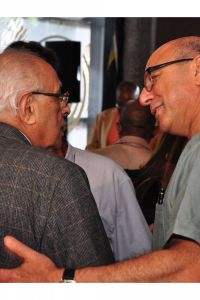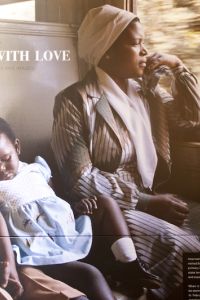It was as a 13-year-old boy growing up in the American Midwest of 1968, around the time of Dr Martin Luther King’s assassination, that photographer David Turnley first heard the word “apartheid” – and the name Nelson Mandela.
David Turnley
His father, who had protested the invitation extended to two pro-racism speakers by the local Rotary Club, had explained the term and told him about the imprisoned Mr Mandela. Little could that impressionable lad have imagined that, two decades later, he would become a close personal friend of the Mandela family, and document South Africa’s transition to democracy from a very special vantage point.
This incredible journey, and more specifically the period between 1985 and 1995, is the subject of For Madiba with Love, Turnley’s new exhibition at the Nelson Mandela Centre of Memory in Houghton, Johannesburg.
Turnley (58) has photographed many of the seminal global events and flashpoints of the late 20th century and early 21st century – Afghanistan, the Middle East, the Berlin Wall, the student protests in Beijing’s Tiananmen Square, Chechnya and many others – and the end of apartheid. He has won the Pulitzer Prize, two World Press Photos of the Year and the Robert Capa Gold Medal of Courage, among many other accolades, for his work.
He first crossed paths with renowned South Africa photographer Peter Magubane in 1978, when Magubane travelled to the United States to show his images of the 1976 Soweto uprising. “He had the most generous spirit, and his work was unbelievable,” Turnley says of the man who would later also become a close friend.
In 1980 Turnley began photographing race issues in Detroit, “no more opportune” a place to document the ongoing civil rights situation in America – including race riots, and the de facto racial segregation of black inner cities and white suburbia. Five years later apartheid had become an international issue, and Turnley’s attention was drawn to South Africa.
“The country was exploding,” he recalls, arriving at a time when South Africa was in deep crisis. The national state of emergency was in force, and the country was torn by violent conflict and brutal State suppression of opposition to apartheid.
As he documented what he saw, and observed the intricacies of racial politics in South Africa, Turnley says that “what I think interested me was the daily humiliations, the nuances of ... this racial relationship”.
He got to know Allan Boesak, then a leading light of the United Democratic Front (UDF), who invited him to an underground meeting of the UDF leadership in Durban. It was to be a defining moment. He says: “I went, and in walks the who’s who of the struggle in the UDF, and the unbelievably beautiful Winnie Mandela.”
It was there that he once again encountered Magubane, whom he respected too much to simply approach. But Magubane had already noticed the young American, whom he described as “one tough cookie”, and their friendship was soon established. Turnley remembers Magubane’s advice: “Don’t talk, and if you do talk, don’t say anything.”
It was Magubane who introduced him to Winnie Mandela, “and we hit it off from day 1”. He became a trusted friend of the Mandela family, enjoying “a very privileged relationship” with them – so close, in fact, that he even babysat for them.
But the apartheid regime, which kept a close watch on foreign media, was growing intolerant of Turnley’s presence and work, and in 1988 deported him. This was a difficult time for Turnley, who had married a South African, but was now persona non grata.
A year later, in late 1989, things had changed again, and the apartheid government – aware of momentous things looming – invited him to return to South Africa and document what was to happen. Turnley would be one of those fortunate photographers who captured a jubilant Mr Mandela walking out of Victor Verster Prison with his wife, and his first public appearance on the steps of the Cape Town City Hall a few hours later. He was also in the Mandela home in Soweto when Mr Mandela took his first meal there in decades, along with the Sisulus and Ahmed Kathrada.
“I spent so much time with Madiba,” he says of the ensuing years, covering Mr Mandela on the campaign trail, the first democratic elections in 1994, and Mr Mandela’s presidency, retirement and family life. “I’ve really been photographing the family for 30 years.”
And so it is that Turnley, too, has a South African family. His son, Charlie, was born in 1994 and has grown up South African. For Turnley, who has worked in 75 countries, “without even hesitation I say South Africa” when he is asked about his favourite place in the world.
“My life changed the minute I arrived in 1985, and I cannot say ‘thank you’ enough to the people of South Africa for letting me into their lives,” he says.

